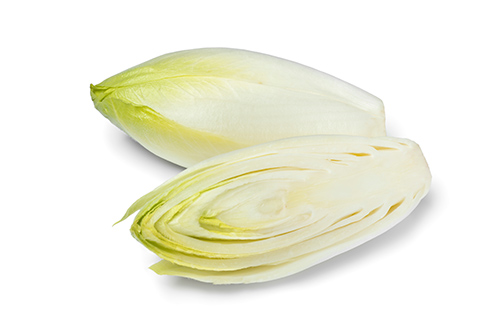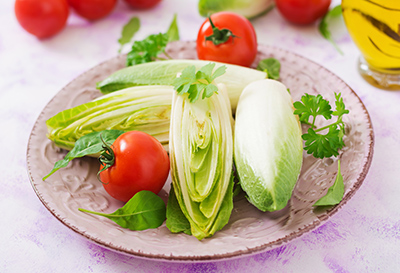Contents
To find the perfect endive, one cannot leave Brussels and must consider the three requirements of forced vegetable cultivation: humidity, heat, and darkness. The Belgian endive is, in reality, a variety of chicory obtained using forced or artificial growing techniques. In the nineteenth century, Belgian farmers discovered that chicory roots stored in a hot, humid, dark environment produced very tender white sprouts.

Endive Nutritional Facts
Belgian endive has a delightful texture and flavor. As it is an artificially grown plant, it has fewer nutrients and active substances than other chicory varieties, including wild chicory. However, refined Western palates find the white endive more acceptable than different varieties. Belgian endive is 94.5 percent water. Proteins comprise 0.9 percent of its weight, which is significant since this is a fresh vegetable.
Its carbohydrates, the most abundant of inulin, do not reach one percent. Its fat content is practically nonexistent (0.1 percent). Taken together, the Belgian endive provides 17 kcal/100 grams, one of the lowest figures of any food. Belgian endive is a good source of folic acid (37 mg/100 grams) and vitamin B1 (thiamin). Vitamin B2, B6, and niacin are also present. It contains minimal vitamin A or C, unlike green-leafed chicory, which is exceptionally rich in these vitamins.
As far as minerals are concerned, they contain small amounts of calcium, phosphorus, magnesium, and iron. It is rich in potassium and contains trace elements of zinc, copper, and manganese. Belgian endives contain the same bitter substances in green chicory but in lower amounts. This is what gives it a slightly bitter taste. These substances act on the liver, increasing bile production (choleretic action) and facilitating gallbladder drainage (cholagogic action). It also serves as an aperitif and a tonic for the stomach and digestive functions.
Belgian Endive Benefits
Belgian endives are helpful in the following cases:
Gallbladder disorders – Due to calculi or interference of its correct drainage. The valuable action of the bitter elements in the Belgian endive and its fundamental lack of fat makes it very easy to digest.

Diabetes – Belgian Endive is a perfect food for people with diabetes since it contains few carbohydrates. Those present are primarily formed of fructose (inulin is a polymer of fructose). This most straightforward sugar requires less inulin to be metabolized, contrary to glucose, which needs more. Consequently, it is very well tolerated by people with diabetes.
Experiments with laboratory animals show that Belgian endive extracts slow glucose absorption in the small intestine. Therefore, people with diabetes who eat endives and other foods do not experience sudden increases in blood glucose levels.
Obesity – Belgian endives require a certain amount of chewing and contain very few calories. This makes them very appropriate for weight-loss diets.
Belgian Endive Scientific Facts
- Scientific name – Cichorium intybus L. var. foliosum
- Other names – Witloof, French endive, Endive.
- French – Endive.
- Spanish – Endivia, achicoria blanca.
- German – Chicorée
- Description—Belgian endive leaves are an herbaceous plant in the botanical family Compositae. This variety of chicory is derived by sprouting its roots in a dark, hot, humid place.
- Environment – Endives are cultivated in Belgium, France, The Netherlands, Germany, the United States, and Canada.
Chicory and Escarole
Chicory (Cichorium intybus L.) is a species that has been the source of various edible varieties.
- The Belgian endive is described in this article.
- Wild chicory – The leaves and roots are used of this quite bitter but very medicinal plant.
- Leaved chicory, or ‘catalogna’, is cultivated in Mediterranean countries, mainly Italy. Its dark green leaves are comparable to those of a dandelion. It is pretty bitter and incredibly rich in vitamin A.
- Radicchio—This type of endive with wine-colored leaves is prevalent in Italy and is used as any other endive.

The endive belongs to the same genus Cichorium as the Belgian endive, but it constitutes a different species. There are two varieties of endive.
- Escarole (Cichorium endivia L. var. latifolium),
- Curly endive (Cichorium endivia L. var. crispum).
Both are rich in provitamin A (205 ug RE/100 grams), folic acid (142 ug/100 grams), and zinc (0.79 ug/100 grams), a trace element that is usually scarce in plant-based foods.
The escarole also contains a bitter element that stimulates the digestive organs and helps drain the gallbladder. In addition to being cholagogic and choleretic, it is mildly diuretic and alkalizing. It is generally eaten in salad and is especially effective in gallbladder disorders and obesity.
How to use and Prepare Belgian Endive
- RAW is the ideal form to eat them. Seasoned with olive oil and lemon; it is healthful and highly digestible.
- COOKED—Either boiled (served with mayonnaise and asparagus) or baked in the oven as part of various dishes.
DISCLAIMER: All content on this website is presented solely for educational and informational objectives. Do not rely on the information provided as a replacement for advice, diagnosis, or treatment from a qualified medical expert. If you are pregnant, nursing, or have any preexisting medical concerns, talk to your doctor before using any herbal or natural medicines.
REFERENCES
- George D. Pamplona-Roger, M.D. “Encyclopedia of Foods and Their Healing Power.” George D. Pamplona-Roger, M.D. Encyclopedia of Foods and Their Healing Power. Trans. Annette Melgosa. Vol. 2. Chai Wan: Editorial Safeliz, 2005. 175, 176. Print.
- HealthifyMe: https://www.healthifyme.com/blog/endives
- National Institutes of Health (NIH): https://www.ncbi.nlm.nih.gov/pmc/articles/PMC7828598
- Nutrition Data: https://nutritiondata.self.com/facts/vegetables-and-vegetable-products/2413/2
Last update on 2025-06-01 / Affiliate links / Images from Amazon Product Advertising API





